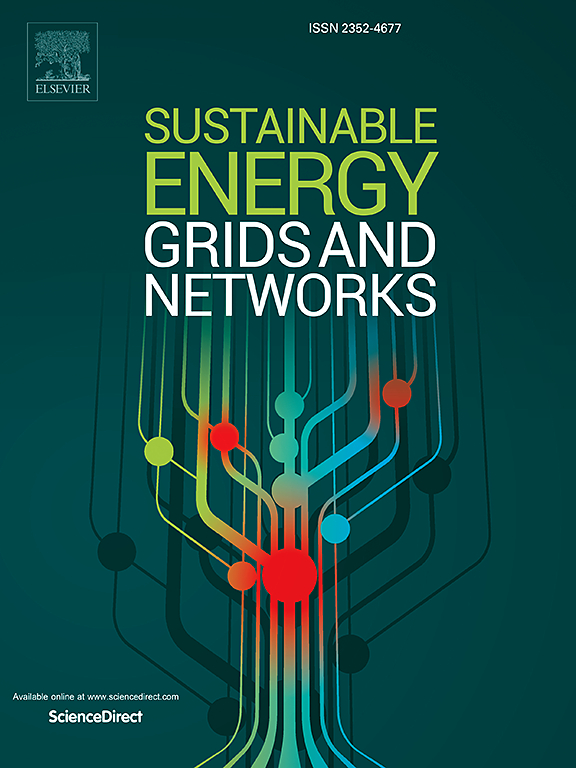Context-aware state estimation in battery management systems: Leveraging nonlinear dynamics with physics-guided parameter identification
IF 5.6
2区 工程技术
Q2 ENERGY & FUELS
引用次数: 0
Abstract
Black accurate remaining range estimation remains a critical issue to promote plug-in and electric vehicle adoption, primarily due to underlying uncertainties in voltage and current-dependent state estimation. To overcome these challenges, the proposed work introduces a novel framework for range estimation while integrating an enhanced equivalent circuit model with a physics-guided temperature-compensated Extended Kalman Filter algorithm. Firstly, comprehensive mathematical models are developed and validated that integrate: (i) proposed enhanced 3rd-order equivalent circuit modeling (p-eTECM) with control parameter optimization, (ii) data-and-model-driven parameter identification using Coulomb counting and voltage scaling analysis, (iii) comprehensive sensitivity analysis to rank important parameters to improve accuracy, and (iv) application-specific model selection criteria based on performance trade-offs. However, unlike existing frameworks that incorporate higher-order RC models that are universally superior, the proposed work identifies that model selection should be application-dependent for different battery management functions. The novel contributions include: parameter & voltage optimization from the pack-level, while systematically eliminating voltage bias through online parameter optimization, and developing a comprehensive sensitivity analysis algorithm to validate the improvements. The proposed framework demonstrates that parameter calibration is more crucial with capacity correction and voltage scaling, to eliminate systematic biases that render models impractical. This study further reveals that 3rd-order model outperforms in voltage prediction (8.3 % improvement) while the 2nd-order model provides better SOC tracking (13 % improved accuracy), establishing clear application-specific selection criteria. Key results demonstrate that both models have achieved excellent performance in terms of SOC errors (0.2 %), and range accuracy (155–170 km) with real-time computational efficiency, validating the practical applicability for diverse battery management applications while providing a systematic methodology for future battery modeling research.
电池管理系统中的环境感知状态估计:利用非线性动力学与物理指导参数识别
黑色准确的剩余里程估计仍然是促进插电式和电动汽车采用的关键问题,主要是由于电压和电流依赖状态估计的潜在不确定性。为了克服这些挑战,本文提出了一种新的距离估计框架,同时将增强型等效电路模型与物理引导的温度补偿扩展卡尔曼滤波算法集成在一起。首先,开发并验证了综合数学模型,该模型集成了:(i)提出的具有控制参数优化的增强三阶等效电路建模(p-eTECM), (ii)使用库仑计数和电压缩放分析的数据和模型驱动的参数识别,(iii)综合灵敏度分析对重要参数进行排序以提高准确性,以及(iv)基于性能权衡的特定应用模型选择标准。然而,与现有的包含普遍优越的高阶RC模型的框架不同,提出的工作确定模型选择应该取决于不同电池管理功能的应用。新的贡献包括:从包级进行参数&电压优化,同时通过在线参数优化系统地消除电压偏置,并开发了一种综合灵敏度分析算法来验证改进。所提出的框架表明,参数校准对于容量校正和电压缩放更为重要,以消除使模型不切实际的系统偏差。该研究进一步表明,三阶模型在电压预测(提高8.3%)方面优于二阶模型,而二阶模型提供了更好的SOC跟踪(提高13%的精度),建立了明确的特定应用选择标准。关键结果表明,两种模型在SOC误差(< 0.2%)和距离精度(155-170 km)方面都取得了优异的性能,具有实时计算效率,验证了不同电池管理应用的实际适用性,同时为未来电池建模研究提供了系统的方法。
本文章由计算机程序翻译,如有差异,请以英文原文为准。
求助全文
约1分钟内获得全文
求助全文
来源期刊

Sustainable Energy Grids & Networks
Energy-Energy Engineering and Power Technology
CiteScore
7.90
自引率
13.00%
发文量
206
审稿时长
49 days
期刊介绍:
Sustainable Energy, Grids and Networks (SEGAN)is an international peer-reviewed publication for theoretical and applied research dealing with energy, information grids and power networks, including smart grids from super to micro grid scales. SEGAN welcomes papers describing fundamental advances in mathematical, statistical or computational methods with application to power and energy systems, as well as papers on applications, computation and modeling in the areas of electrical and energy systems with coupled information and communication technologies.
 求助内容:
求助内容: 应助结果提醒方式:
应助结果提醒方式:


